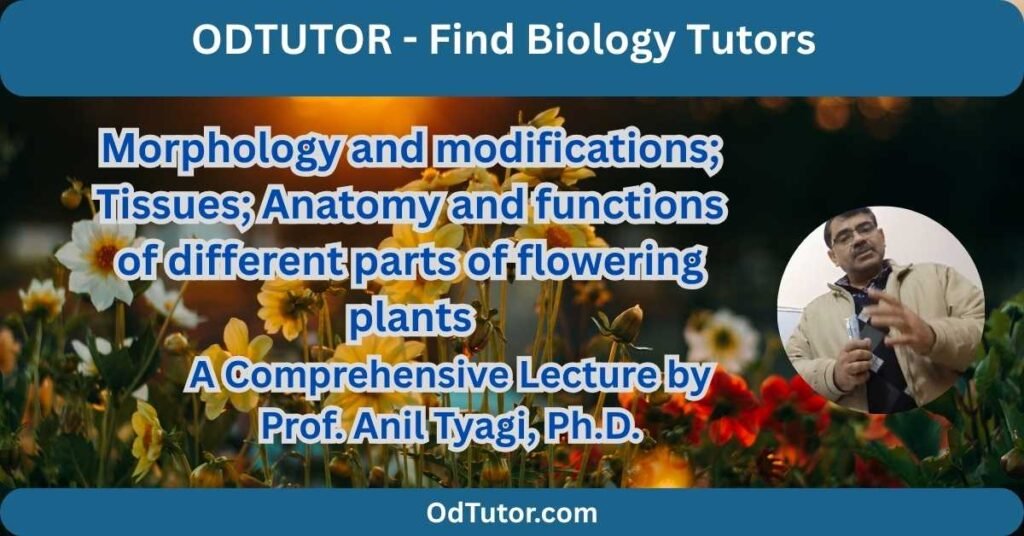NEET UG BIOLOGY: ANATOMY OF FLOWERING PLANTS NOTES
Unit 1 Notes
A Comprehensive Lecture by Prof. Anil Tyagi, Ph.D.
Welcome, future doctors. Just as you will study the gross and microscopic anatomy of the human body, we must do the same for plants. A flowering plant is a highly organized entity, and every part of it, from the root to the flower, has a specific structure and function. Mastering this will help you answer countless questions in your NEET exam with confidence.
Part 1: Morphology of Flowering Plants – The External Study of Form
Morphology is the study of the external form and structure of plants. The body of a typical flowering plant (a sporophyte) is differentiated into two main systems: the Root System (underground) and the Shoot System (above ground).
I. The Root System
- Function: Primarily for anchorage, absorption of water and minerals, and storage.
- Regions of a Root:
- Root Cap: A protective thimble-like structure that covers the delicate root apex as it pushes through the soil.
- Region of Meristematic Activity: Cells are small, thin-walled, and actively dividing.
- Region of Elongation: Cells elongate and enlarge, responsible for the growth of the root in length.
- Region of Maturation: Cells differentiate and mature. This zone has root hairs that significantly increase the surface area for water absorption.
- Types of Root Systems:
- Tap Root System: The primary root (radicle) grows and gives rise to lateral (secondary & tertiary) roots. Found in dicots (e.g., Mustard, Gram, Mango).
- Fibrous Root System: The primary root is short-lived and is replaced by a large number of roots originating from the base of the stem. Found in monocots (e.g., Wheat, Rice, Grasses).
- Adventitious Root System: Roots that arise from any part other than the radicle (e.g., from stem, leaves). Example: Grass, Banyan tree, Maize.
- Modifications of Roots: Roots can modify their structure for specialized functions.
- For Storage of Food: Tap roots become fleshy and swollen.
- Conical: Carrot
- Fusiform: Radish
- Napiform: Turnip, Beetroot
- For Support:
- Prop Roots: Banyan tree
- Stilt Roots: Maize, Sugarcane
- For Respiration (Pneumatophores): Roots that grow upwards out of the water-logged soil to obtain oxygen. Example: Rhizophora (Mangrove).
- For Storage of Food: Tap roots become fleshy and swollen.
II. The Shoot System
The shoot system consists of the stem, branches, leaves, flowers, and fruits.
A. The Stem
- Function: Spreads out branches, bears leaves, flowers, and fruits; conducts water, minerals, and photosynthates; can store food.
- Modifications of Stem:
- For Storage: Become swollen and underground.
- Rhizome: Ginger, Turmeric
- Tuber: Potato (the “eyes” are axillary buds)
- Bulb: Onion, Garlic
- Corm: Colocasia, Gladiolus
- For Support and Climbing:
- Tendrils: Passiflora, Grapevine
- For Vegetative Propagation:
- Runner: Lawn Grass, Oxalis
- Sucker: Mint, Chrysanthemum
- Offset: Eichhornia (Water Hyacinth), Pistia
- For Storage: Become swollen and underground.
B. The Leaf
- Function: Photosynthesis, transpiration, and gas exchange.
- Parts of a Leaf:
- Leaf Base: The point of attachment to the stem. May have stipules (leaf-like appendages).
- Petiole: The stalk.
- Lamina (Leaf Blade): The green, expanded part with veins and veinlets.
- Venation: The arrangement of veins and veinlets.
- Reticulate: Veins form a network. Found in dicots.
- Parallel: Veins run parallel to each other. Found in monocots.
- Phyllotaxy: The pattern of leaf arrangement on the stem.
- Alternate: One leaf per node (e.g., Mustard)
- Opposite: Two leaves per node, opposite each other (e.g., Calotropis)
- Whorled: More than two leaves per node (e.g., Alstonia)
- Modifications of Leaves:
- For Defence: Spines (e.g., Cactus)
- For Climbing: Tendrils (e.g., Pea)
- For Storage: Fleshy leaves (e.g., Onion)
- For Insectivory: Pitcher (e.g., Nepenthes), Venus flytrap.
C. The Inflorescence, Flower, and Fruit
- Inflorescence: The arrangement of flowers on the floral axis.
- Racemose: The main axis grows indefinitely, flowers bloom in acropetal succession (older at base, younger at top). Example: Mustard, Radish.
- Cymose: The main axis terminates in a flower, flowers bloom in basipetal succession (older at top, younger at base). Example: Jasmine, Bougainvillea.
- Flower: The reproductive unit. We will cover its detailed structure in a separate lecture on sexual reproduction.
- Fruit: The mature, ripened ovary, developed after fertilization, containing seeds.
Part 2: Plant Tissues – The Internal Fabric
A tissue is a group of cells with a common origin and function. Plant tissues are broadly classified into two types: Meristematic and Permanent.
I. Meristematic Tissues
- Feature: Cells are actively dividing, thin-walled, rich in cytoplasm, and lack vacuoles.
- Classification based on Location:
- Apical Meristem: Present at the tips of roots and shoots. Responsible for primary growth (increase in length).
- Intercalary Meristem: Found at the base of leaf blades or internodes (e.g., Grasses). Also responsible for primary growth.
- Lateral Meristem: Present in the radial plane, responsible for secondary growth (increase in girth/diameter).
- Vascular Cambium: Produces secondary xylem and phloem.
- Cork Cambium (Phellogen): Produces the cork (bark).
II. Permanent Tissues
These are derived from meristematic tissues, have lost the power to divide, and are specialized in function. They are of two types: Simple (one cell type) and Complex (more than one cell type).
A. Simple Permanent Tissues
- Parenchyma:
- Structure: Living, thin-walled, loosely packed cells.
- Function: Storage, photosynthesis (chlorenchyma), buoyancy (aerenchyma).
- Collenchyma:
- Structure: Living, thickened at corners (pectin and cellulose), provide mechanical support.
- Function: Provides mechanical support to growing stems and leaves.
- Sclerenchyma:
- Structure: Dead cells, thick-walled due to lignin. Two types: Fibers (long, slender) and Sclereids (short, irregular).
- Function: Provides rigid mechanical support.
B. Complex Permanent Tissues (The Conducting Tissues)
These are the xylem and phloem, which together form the vascular bundle.
- Xylem:
- Function: Conduction of water and minerals from roots to shoots. Also provides mechanical strength.
- Components: (Four types of cells)
- Tracheids: Elongated, dead cells with tapered ends and lignified walls.
- Vessels: Long, cylindrical, tube-like structures, dead at maturity. More efficient than tracheids.
- Xylem Fibers: For support.
- Xylem Parenchyma: Living, for storage.
- Phloem:
- Function: Conduction of organic food materials (photosynthates) from leaves to other parts.
- Components: (Four types of cells)
- Sieve Tube Elements: Long, tube-like, living but lack a nucleus at maturity. Connected end-to-end by sieve plates.
- Companion Cells: Living, nucleated cells connected to sieve tubes by plasmodesmata. They control the function of sieve tubes.
- Phloem Fibers: For support.
- Phloem Parenchyma: For storage.
Part 3: Anatomy of Flowering Plants – The Internal Structure
Anatomy is the study of the internal structure of plants, visible through a microscope.
I. The Tissue System
There are three main tissue systems:
- Epidermal Tissue System: Forms the outer covering (epidermis and cuticle). Has stomata for gas exchange and trichomes (hairs).
- Ground Tissue System: All tissues except epidermis and vascular bundles. It consists of parenchyma, collenchyma, and sclerenchyma. Its functions include storage, secretion, and support.
- Vascular Tissue System: Consists of xylem and phloem, arranged in vascular bundles.
II. Anatomy of Stem, Root, and Leaf
A. Anatomy of the Dicot Stem (e.g., Sunflower)
- Epidermis: Outermost layer with a thick cuticle, may have trichomes.
- Cortex: Multi-layered, consists of:
- Hypodermis: Collenchymatous for mechanical support.
- General Cortex: Parenchymatous for storage.
- Endodermis: The innermost layer of the cortex, rich in starch grains.
- Pericycle: A few layers of sclerenchymatous cells.
- Vascular Bundles: Arranged in a ring (open collateral). Each bundle has phloem (outside), xylem (inside), and fascicular cambium in between.
- Pith: Large, central parenchymatous tissue for storage.
B. Anatomy of the Monocot Stem (e.g., Maize)
- Vascular Bundles: Scattered in the ground tissue.
- Vascular Bundles are Conjoint and Closed (no cambium), so no secondary growth.
- Hypodermis is Sclerenchymatous for support.
- No clear distinction between cortex, pericycle, pith, etc.
C. Anatomy of the Dicot Root (e.g., Gram)
- Epidermis: Single-celled, some cells protrude to form root hairs.
- Cortex: Consists of many layers of thin-walled parenchyma.
- Endodermis: The innermost layer of the cortex, with characteristic Casparian strips (suberin deposits) that regulate the movement of water into the xylem.
- Pericycle: Lateral roots arise from the pericycle.
- Vascular Bundles: Radial (xylem and phloem in separate patches). Xylem is exarch (protoxylem towards the periphery).
- Pith: Small or inconspicuous.
D. Anatomy of the Monocot Root (e.g., Maize)
- Similar to dicot root with:
- Radial vascular bundles.
- Polyarch condition (many xylem and phloem patches).
- A large, well-developed pith.
E. Anatomy of a Dicot Leaf (Dorsiventral Leaf)
- Epidermis: On both upper (adaxial) and lower (abaxial) surfaces. The abaxial epidermis has more stomata.
- Mesophyll: The ground tissue, differentiated into:
- Palisade Parenchyma: Adaxially placed, elongated cells, tightly packed, main site for photosynthesis.
- Spongy Parenchyma: Below palisade, loosely arranged with air cavities for gas exchange.
- Vascular System: Vascular bundles are seen in the veins and the midrib. They are conjoint and closed.
F. Anatomy of a Monocot Leaf (Isobilateral Leaf)
- Stomata are present on both surfaces.
- Mesophyll is not differentiated into palisade and spongy parenchyma.
Professor Tyagi’s Key Takeaways for NEET Success:
- Morphology is Visual: Draw and label the parts of a plant, a leaf, and a root. This will help you remember modifications and their examples.
- Tissues are Fundamental: The difference between meristematic and permanent tissues, and the components of xylem and phloem are high-yield topics.
- Anatomy is Comparative: Create a table to compare the anatomy of Dicot vs. Monocot stems and roots. Focus on the arrangement of vascular bundles.
- Link Structure to Function: Why does a root have a root cap? Why is xylem made of dead cells? Why is the mesophyll in a dicot leaf differentiated? Always ask “why” – it makes the concept stick.
- Examples are Crucial: Memorize the examples for each modification (e.g., Ginger is a rhizome, Potato is a tuber). Direct questions are frequently asked.
This unit is a blend of rote memory and logical understanding. Focus on the logic, and the memory will follow.
Your consistent effort in building these foundational concepts is what will lead you to a top score in NEET. Keep up the excellent work.
– Prof. Anil Tyagi

